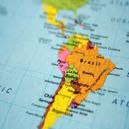Проанализированы предварительные итоги переформатирования политического ландшафта в начале нового электорального цикла, причины и последствия прихода к власти широкого спектра левых сил. В условиях «правого дрейфа», начавшегося после «золотого десятилетия» (2003 – 2013), политические разногласия привели к обострению межгосударственных разногласий и затормозили экономическую и политическую интеграцию. Социально-экономическая ситуация и динамика политических процессов в начале нынешнего десятилетия показывают, что между странами региона сохраняются существенные различия, в том числе и среди государств левого спектра. В то же время прилив новой «розовой волны» способствует сближению их позиций, а у Латинской Америки вновь появляется шанс восстановить единство в многообразии и превратиться в самостоятельный полюс формирующегося полицентричного мира.
The article analyzes the preliminary results of the reformatting of the political landscape at the beginning of a new electoral cycle, the causes and consequences of the coming to power of the heterogeneous of leftist forces. During the “right drift” after the “golden decade” (2003-2013), political disagreements led to an aggravation of interstate disagreements and slowed down economic and political integration. The socio-economic situation and the dynamics of political processes at the beginning of this decade indicate that there are still significant differences between the countries of Latin America, including the states of the left spectrum. At the same time, the influx of a new “pink wave” to some extent contributes to the rapprochement of their positions, and Latin America has a new chance to restore “unity in diversity” and become an independent pole of the emerging polycentric world.
 Ранний опыт государственного строительства большевиков и Конституция РСФСР 1918 года
Ранний опыт государственного строительства большевиков и Конституция РСФСР 1918 года
 7
7
 25332
|
Официальные извинения
25332
|
Официальные извинения
 972
972
 105061
|
Становление корпоративизма в современной России. Угрозы и возможности
105061
|
Становление корпоративизма в современной России. Угрозы и возможности
 239
239
 84616
84616

